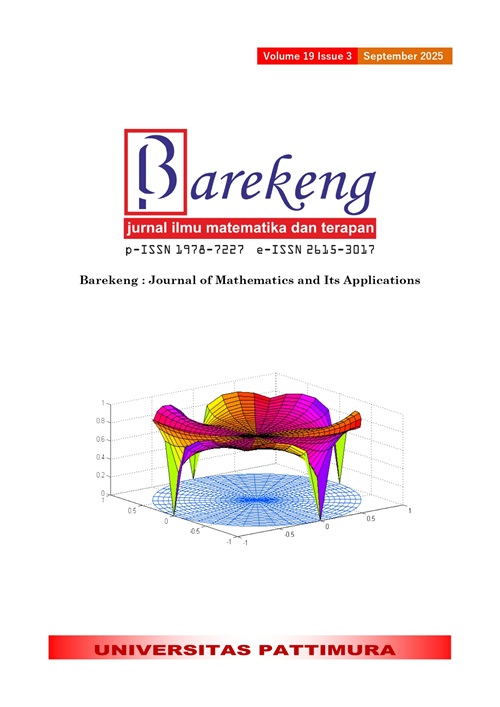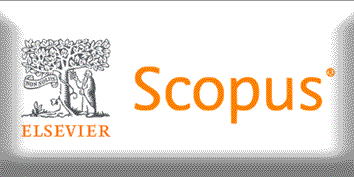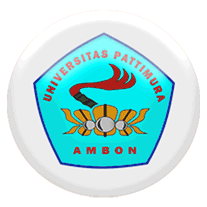DYNAMIC ANALYSIS OF PREDATOR-PREY MODEL WITH CANNIBALISM INTERVENTION AND DISEASE INFECTION IN PREY USING HOLLING TYPE II RESPONSE FUNCTION
Abstract
This study discusses the intervention of cannibalism and disease spread with Holling Type II response function in the predator-prey model. It is assumed that disease infection is limited to the prey population and cannot be cured so that in this model there are three subpopulations namely susceptible prey, infected prey and predators. In addition, there is cannibalism in the predator population. The objectives of this study include constructing a predator-prey model with cannibalism intervention and disease infection in prey using Holling Type II response function, identifying the stability of the equilibrium point of the model and interpreting the model based on simulation results. Analysis of the stability of the equilibrium point is carried out with a linearization approach and the Routh-Hurwitz criterion was used to determine equilibrium stability. Based on the stability analysis, 5 (five) equilibrium points are obtained, namely population extinction, susceptible prey exists, predator extinction, infected prey extinction and population exists where the population extinction equilibrium point is unstable and the other equilibrium points are stable with the certain conditions. From the simulation, it is obtained that the numerical results are in accordance with the analytical results of the stability analysis of the equilibrium point of the model and for infinite time, there will be no population extinction while the state of susceptible prey exists, predator extinction, infected prey extinction and population exists can occur if the stability conditions are met. Based on the numerical simulations, it was found that changes in the parameter values of the rate of change of susceptible prey to infected prey and the coefficient of predator cannibalism in day-1 can cause changes in the type of stability of the equilibrium point. Thus, rate of change susceptible prey to infected prey and the coefficient of predator cannibalism affects the population of prey and predator.
Downloads
References
M. K. Teta Resti Anggraeni, “ANALISIS MODEL PREDATOR-PREY DENGAN DINAMIKA POPULASI,” vol. 10, no. 2, pp. 56–65, 2021,doi:https://doi.org/10.15294/ujm.v10i2.51136.
B. Roy, S. K. Roy, and D. B. Gurung, “HOLLING-TANNER MODEL WITH BEDDINGTON-DEANGELIS FUNCTIONAL RESPONSE AND TIME DELAY INTRODUCING HARVESTING,” Mathematics and Computers in Simulations, vol. 142, pp. 1–14, 2017, doi: https://doi.org/10.1016/j.matcom.2017.03.010
A. Mufidah and D. Savitri, “ANALISIS KESTABILAN MODEL MANGSA PEMANGSA DENGAN MAKANAN TAMBAHAN PADA PEMANGSA MENGGUNAKAN FUNGSI RESPON HOLLING TIPE IV,” J. Ris. dan Apl. Mat., vol. 7, no. 1, pp. 80–94, 2023, doi: https://doi.org/10.26740/jram.v7n1.p80-94.
G. E. Waldhani and Chalimatusadiah, “GAMMA-PI: JURNAL MATEMATIKA DAN TERAPAN VOLUME 5 NOMOR 2 DESEMBER 2023 BIFURKASI HOPF PADA MODEL DINAMIK S-I-P DENGAN PENYAKIT PADA POPULASI PREYDAN FUNGSI RESPON DENGAN PENYAKIT PADA POPULASI PREY DAN FUNGSI RESPON HOLLING TYPE II,” J. Gamma-Pi, vol. 5, pp. 48–59, 2023.doi: https://doi.org/10.33059/gamma-pi.v5i2.8606
A. Lahay, M. R. F. Payu, S. L. Mahmud, H. S. Panigoro, and P. Zakaria, “DYNAMICS OF A PREDATOR-PREY MODEL INCORPORATING INFECTIOUS DISEASE AND QUARANTINE ON PREY,” Jambura J. Biomath., vol. 3, no. 2, pp. 75–81, 2022, doi: https://doi.org/10.34312/jjbm.v3i2.17162.
N. Hasan, R. Resmawan, and E. Rahmi, “ANALISIS KESTABILAN MODEL EKO-EPIDEMIOLOGI DENGAN PEMANENAN KONSTAN PADA PREDATOR,” J. Mat. Stat. dan Komputasi, vol. 16, no. 2, p. 121, 2019, doi: https://doi.org/10.20956/jmsk.v16i2.7317.
T. Herlambang, A. Y. P. Asih, D. Rahmalia, D. Adzkiya, and N. Aini, “THE EFFECTS OF PESTICIDE AS OPTIMAL CONTROL OF AGRICULTURE PEST GROWTH DYNAMICAL MODEL,” Nonlinear Dyn. Syst. Theory, vol. 22, no. 3, pp. 281–290, 2022.doi:https://e-ndst.kiev.ua/v22n3/4(83)
K. Mu’tamar and Zulkarnain, “MODEL PREDATOR-PREY DENGAN ADANYA INFEKSI DAN PENGOBATAN PADA POPULASI MANGSA,” J. Sains, Teknol. dan Ind., vol. 15, no. 1, pp. 1–6, 2017.doi:http://dx.doi.org/10.24014/sitekin.v15i1.4222
R. A. Pratama, “IMPACT OF FEAR BEHAVIOR ON PREY POPULATION GROWTH PREY-PREDATOR INTERACTION,” BAREKENG J. Ilmu Mat. dan Terap., vol. 16, no. 2, pp. 371–378, 2022, doi: https://doi.org/10.30598/barekengvol16iss2pp371-378.
M. K. Dewi, D. Savitri, and Abadi, “DYNAMICAL BEHAVIOR IN THE COMPETITIVE MODEL INCORPORATING THE FEAR EFFECT OF PREY DUE TO ALLELOPATHY WITH SHARED BIOTIC RESOURCES,” Barekeng, vol. 18, no. 4, pp. 2663–2674, 2024, doi: https://doi.org/10.30598/barekengvol18iss4pp2663-2674.
W. O. K. and A. G. MCKENDRiCK, “CONTRIBUTIONS TO THE MATHEMATICAL THEORY OF EPIDEMICS--I*,” vol. 53, no. 1, pp. 700–721, 1991.doi: https://doi.org/10.1016/S0092-8240(05)80040-0
S. Maisaroh, R. Resmawan, and E. Rahmi, “ANALISIS KESTABILAN MODEL PREDATOR-PREY DENGAN INFEKSI PENYAKIT PADA PREY DAN PEMANENAN PROPORSIONAL PADA PREDATOR,” Jambura J. Biomath., vol. 1, no. 1, pp. 8–15, 2020, doi: https://doi.org/10.34312/jjbm.v1i1.5948.
F. Ni’mah and D. Savitri, “ANALISIS KESTABILAN MODEL EKO-EPIDEMIOLOGI DENGAN FUNGSI RESPON HOLLING TIPE I,” MATHunesa J. Ilm. Mat., vol. 10, no. 1, pp. 1–12, 2022, doi: https://doi.org/10.26740/mathunesa.v10n1.p1-12.
M. Miswanto, N. Suroiyah, and W. Windarto, “ANALISIS KESTABILAN MODEL PREDATOR PREY LESLIE GOWER DENGAN FUNGSIONAL RESPON CROWLEY MARTIN DAN ADANYA PREY TERINFEKSI SERTA FAKTOR KETAKUTAN,” Limits J. Math. Its Appl., vol. 20, no. 3, p. 355, 2023, doi: https://doi.org/10.12962/limits.v20i3.18530.
H. Deng, F. Chen, Z. Zhu, and Z. Li, “DYNAMIC BEHAVIORS OF LOTKA–VOLTERRA PREDATOR–PREY MODEL INCORPORATING PREDATOR CANNIBALISM,” Adv. Differ. Equations, vol. 2019, no. 1, pp. 1–17, 2019, doi: https://doi.org/10.1186/s13662-019-2289-8.
F. Zhang, Y. Chen, and J. Li, “DYNAMICAL ANALYSIS OF A STAGE-STRUCTURED PREDATOR-PREY MODEL WITH CANNIBALISM,” Math. Biosci., vol. 307, no. August 2018, pp. 33–41, 2019, doi: https://doi.org/10.1016/j.mbs.2018.11.004.
N. Imamah, W. M. Kusumawinahyu, A. Suryanto, and T. Trisilowati, “THE DYNAMICS OF A PREDATOR-PREY MODEL INVOLVING DISEASE SPREAD IN PREY AND PREDATOR CANNIBALISM,” Jambura J. Biomath., vol. 4, no. 2, pp. 119–125, 2023, doi: https://doi.org/10.37905/jjbm.v4i2.21495.
J. Chattopadhyay & O. Arino, “A PREDATOR-PREY MODEL WITH DISEASE IN THE PREY SPECIES ONLY,” Math. Methods Appl. Sci., vol. 30, no. 8, pp. 911–929, 1999, doi: https://doi.org/10.1002/mma.815.
M. Manaqib, S. Suma’inna, and A. Zahra, “MATHEMATICAL MODEL OF THREE SPECIES FOOD CHAIN WITH INTRASPECIFIC COMPETITION AND HARVESTING ON PREDATOR,” BAREKENG J. Ilmu Mat. dan Terap., vol. 16, no. 2, pp. 551–562, 2022, doi: https://doi.org/10.30598/barekengvol16iss2pp551-562.
S. H. Arsyad, R. Resmawan, and N. Achmad, “ANALISIS MODEL PREDATOR-PREY LESLIE-GOWER DENGAN PEMBERIAN RACUN PADA PREDATOR,” J. Ris. dan Apl. Mat., vol. 4, no. 1, p. 1, 2020, doi: https://doi.org/10.26740/jram.v4n1.p1-16.
I. R. Syarif, S. Toaha, and J. Kusuma, “DYNAMICS ANALYSIS OF PREDATOR-PREY MODEL WITH DOUBLE ALLEE EFFECTS AND HOLLING TYPE II FUNCTIONAL RESPONSE,” J. Mat. Stat. dan Komputasi, vol. 18, no. 3, pp. 434–446, 2022, doi: https://doi.org/10.20956/j.v18i3.19237.
N. L. Aufaniyah and Abadi, “DINAMIKA MODEL INTERAKSI MANGSA PEMANGSA DENGAN FUNGSI RESPON HOLLING TIPE II, MAKANAN TAMBAHAN, DAN PERILAKU ANTI PEMANGSA,” J. Ilm. Mat., vol. 11, no. 3, pp. 422–433, 2023, doi:https://doi.org/10.26740/mathunesa.v11n3.p422-433.
Copyright (c) 2025 Fardinah Fardinah, Hikmah Hikmah, Rahmah Abubakar, Laila Qadrini, Haris Haris, Nadia Salsabilah

This work is licensed under a Creative Commons Attribution-ShareAlike 4.0 International License.
Authors who publish with this Journal agree to the following terms:
- Author retain copyright and grant the journal right of first publication with the work simultaneously licensed under a creative commons attribution license that allow others to share the work within an acknowledgement of the work’s authorship and initial publication of this journal.
- Authors are able to enter into separate, additional contractual arrangement for the non-exclusive distribution of the journal’s published version of the work (e.g. acknowledgement of its initial publication in this journal).
- Authors are permitted and encouraged to post their work online (e.g. in institutional repositories or on their websites) prior to and during the submission process, as it can lead to productive exchanges, as well as earlier and greater citation of published works.






1.gif)



